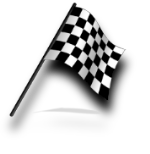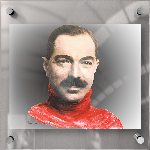UGO SIVOCCI was born in Aversa (Caserta) in 1885.
His mother, Maria Clerice, a housewife, and his father Giuseppe, a professor of piano and a conductor, were often travelling.
During one of these trips, in August 29, 1885, was born Ugo, the first of eight children.
Among his brothers were those who, like him, embarked on a racing career, that is Alfredo, a cycling champion, and those who, like his sister Giuditta, followed their father's profession, devoting herself to music and becoming a teacher of harp. The Ugo’s career as a test pilot began at the beginning of 1900. The first mention of his race dates back to 1906 and regards the uphill course Turin-Colle del Sestriere on OTAV (Officine Turkheimer Automobili e Velocipedi) car of Milan. With this same brand-mark he attended some cycling race as professional getting excellent results still in 1904.
UGO SIVOCCI nacque ad Aversa (CE) nel 1885.
La madre, Maria Clerice, casalinga, ed il padre Giuseppe, professore di pianoforte e direttore d’orchestra, erano spesso in viaggio per motivi di lavoro e durante una di queste trasferte, il 29 agosto, venne alla luce Ugo, primo di 8 figli.
Tra i suoi fratelli ci fu chi, come lui, intraprese una carriera sportiva e mi riferisco ad Alfredo, campione di ciclismo e chi, come sua sorella Giuditta, seguì la professione del padre, dedicandosi alla musica e diventando insegnante di arpa. L’ attività di pilota-collaudatore di Ugo ebbe inizio ai primi del 900.
La prima notizia di una sua gara automobilistica è del 1906, nella corsa in salita Torino - Colle del Sestriere, su vettura O.T.A.V. (Officine Turkheimer Automobili e Velocipedi) di Milano. Con questa stessa marca, già nel 1904, aveva partecipato ad alcune gare ciclistiche, da professionista, con ottimi risultati.

Nel 1907 Sivocci era in De Vecchi con mansione di capomeccanico, collaudatore e pilota e lì incontrò Antonio Ascari, all’epoca semplice meccanico. Anni dopo, Antonio, al suo rientro dal Brasile nel 1910, divenne responsabile del settore riparazioni. Quando, nel 1911, l’attività agonistica si intensificò, fu proprio Ugo Sivocci a convincere il comm. De Vecchi ad affidare ad Ascari una vettura, in vista del Criterium di Modena. Ascari con questa Marca debuttò e gareggiò sino al 1914.
Con la De Vecchi Ugo partecipò alle sue prime gare importanti tra cui, principalmente, la TF del 1913 e quella del ’14.
Con l’arrivo della guerra la De Vecchi si trovò in difficoltà e cercò di riconvertire la propria produzione per l’industria bellica, ma con scarsi risultati. Alla fine del conflitto la De Vecchi dovette chiudere e la sua attività venne rilevata dalla Costruzioni Meccaniche Nazionali, altra società di Milano. Con i macchinari la C.M.N. rilevò anche parte del personale e conseguentemente Ugo tornò a correre con questa nuova vettura.
In 1907 Sivocci was in De Vecchi with the duties of chief mechanic, test driver and pilot and there he met Antonio Ascari, then a simple mechanic who subsequently, on his return from Brazil in 1910, he became head of the repair sector. When, in 1911, the competitive activity intensified, it was Ugo Sivocci who convinced the comm. De Vecchi to entrust a race car to Ascari, in view of the Modena criterium. Ascari with this brand debuted and competed until 1914.
With De Vecchi Ugo participated in his first major races including the TF of 1913 and that of 1914. At the beginning of the War, De Vecchi found itself in difficulties and tried to convert its production into production of components for military uses, however, with poor results.
At the end of the War, De Vecchi had to close its business and was taken over by National Mechanical Constructions (Costruzioni Meccaniche Nazionali, CMN), another company in Milan.
Beside machinery, CMN took over the staff and, consequently, Ugo returned to racing under this new brand.
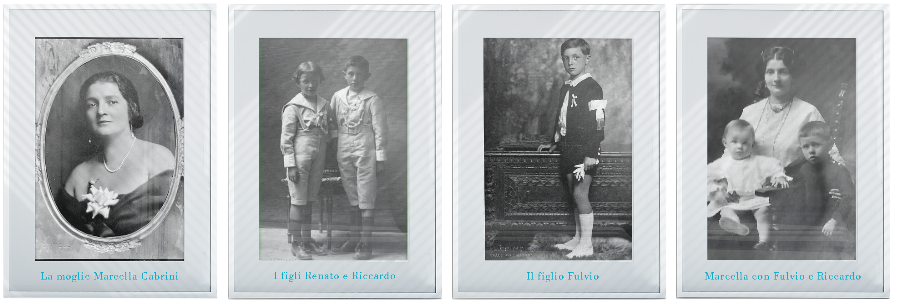
At that time, in Milan stayed also a still unknown boy: Enzo Ferrari.
After the failures in Turin, Enzo sought after his new life in this city, but he encountered a difficult time.
As he wrote in his biography, in the affirmation of the troubles he was facing, he even contemplated suicide.
Fortunately for him, he met Ugo in a pub in Milan (Vittorio Emanuele bar, situated in Orefici street) and they soon became close friends.
Between one job and another, in those years of sacrifice, Enzo Ferrari was a regular guest at home of Ugo and his wife Marcella Cabrini and their children Riccardo and Renato.
In 1919 Ugo offered Enzo a job as a test pilot in CMN and, shortly after, gave him the opportunity to make his debut as a pilot in the Parma-Poggio di Berceto in 1919.
In quel periodo frequentava Milano un ragazzo ancora sconosciuto: Enzo Ferrari che, dopo gli insuccessi di Torino, cercava in questa città la sua strada. Per lui fu un periodo difficilissimo e, come scrisse in una sua biografia, per le difficoltà che stava incontrando nell’affermarsi, meditò addirittura il suicidio. Per sua fortuna conobbe Ugo. Si incontrarono in un locale di Milano, il bar Vittorio Emanuele di via Orefici 7, frequentato dagli sportivi dell’epoca e divennero subito amici fraterni. Ugo e la sua famiglia (la moglie Marcella Cabrini e il loro figli Riccardo e Renato) abitavano in piazzale Rottole, oggi diventata piazza Durante e, tra un lavoro e l’altro, in quegli anni di sacrifici, Enzo Ferrari fu spesso ospite in casa loro. Nel 1919 Ugo propose ad Enzo un lavoro come collaudatore alla C.M.N. e, poco tempo dopo, gli diede la possibilità di debuttare come pilota nella gara Parma-Poggio di Berceto del 1919.
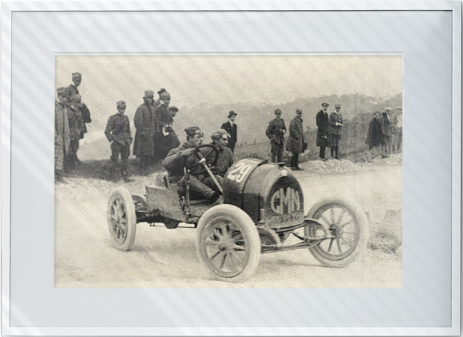

In quello stesso anno parteciparono anche alla 10^ TF, avvenimento da loro ricordato soprattutto per una marcia di avvicinamento molto avventurosa.
Non so se anche le altre case automobilistiche dell’epoca usavano lo stesso metodo, ma alla CMN, per raggiungere il circuito di gara, misero in strada le vetture da corsa con alla guida i due piloti. Sivocci e Ferrari presero quindi la strada per raggiungere Napoli, dove dovevano imbarcarsi per la Sicilia.
Durante il viaggio, in una notte buia e tempestosa (come direbbero nei romanzi d’avventura) sull’altopiano abruzzese delle “5 Miglia” vennero assaliti da un branco di lupi che furono scacciati dalla pistola di Ferrari. Giunti in Sicilia, l’episodio venne subito ripreso e mitizzato dai cronisti locali che fecero diventare i piloti 2 eroi.
L’esito della gara passò in secondo piano, anche perché non fu dei più esaltanti (Sivocci 7° e Ferrari fuori tempo max).
The same year he also participated in the 10th TF, an event they remembered mainly for a very adventurous way of getting to the racetrack.
It is unknown whether the other cars used the same method, but the CMN, to get to the racetrack, used the racing cars under the guidance of two drivers.
So SIVOCCI and Ferrari took the road to Naples, where they were to be embarked for Sicily.
During the trip, on a dark and stormy night (as it would be written in adventure stories) on the plateau of Abruzzo "5 miles" they were attacked by a pack of wolves, which were scared off by the Ferrari’s gun.
Arrived in Sicily, the episode was immediately taken up and mythologized by local reporters that made them become two heroes and the outcome of the race took second place, as it was not the most exciting (SIVOCCI 7th and Ferrari run out of time).
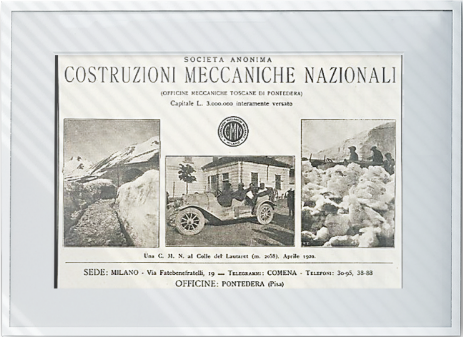
When Ferrari and Sivocci were hired by Alfa Romeo (perhaps also for the interest of their friend Ascari) Ugo, overwhelmed by a serious family mourning, delayed his running debut, which took place only in 1921.
In this way was made the 1st racing team of Alfa Romeo, consisting of Ascari, Campari, Ferrari and SIVOCCI (fans of the time called them "the four musketeers" and first Orio Vergani). Thus, UGO SIVOCCI began to compete with the AR, obtaining good results, with some 1st place in class, but no victory. The first victory came finally in 1923, in the XIV Targa Florio.
On that occasion, before starting, he wondered to paint on the side of his car a green cloverleaf, which since then has never left the Alfa Romeo's most prestigious cars.
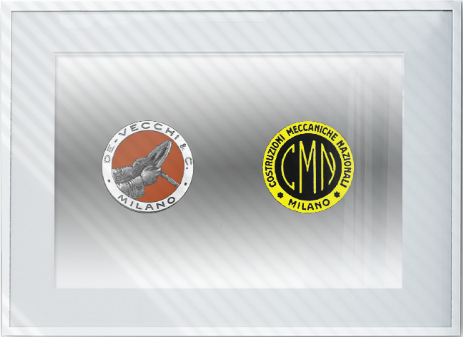
Quando Ferrari e Sivocci furono ingaggiati in Alfa Romeo (forse anche per l’interessamento dell’amico Ascari) Ugo, sopraffatto da un grave lutto famigliare, ritardò il suo debutto in corsa, che avvenne solo nel 1921.
Si costituì così la 1^ squadra corse dell’ Alfa Romeo, composta da Ascari, Campari, Ferrari e Sivocci (i tifosi dell’epoca, e per primo Orio Vergani, li chiamarono “i 4 moschettieri”). Iniziò quindi a gareggiare con l’Alfa Romeo, ottenendo buoni piazzamenti, con qualche 1° posto di categoria, ma nessuna vittoria assoluta. La prima vittoria arrivò finalmente nel 1923, nella XIV Targa Florio.
In quella occasione, prima della partenza, pensò di dipingere sulla fiancata della sua vettura un quadrifoglio verde, che da allora non ha più lasciato le vetture Alfa Romeo più prestigiose.
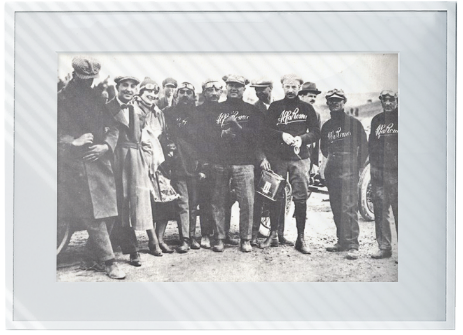
It is said to have been a superstitious gesture, but more likely that first logo was intended to make the car being recognized at first glance, even from a distance, when it ran on the dusty roads of the time. That it was not superstitious was proved by the fact that he won with the car No. 13 and died the same year in Monza in the car No. 17.
The superstition came later on, because from that moment on, no longer the No. 17 has been used in races and, at least in Italy, it is still so.
As mentioned above, Ugo died the same year in Monza during the practice for the Italian Grand Prix, with the rookie Alfa Romeo GrandPrix P1.
His Quadrifoglio, which had not been painted on the side panels of the car yet, remained on a white background in a rhombus shape, so with 4 vertices, as many as were drivers of the Alfa Romeo team.
Since then one of the vertex was removed to commemorate death of SIVOCCI and the symbol known today has a triangular background.
With that race ended up also the collaboration of designer Giuseppe Merosi with Alfa Romeo and began the period of Vittorio Jano, who designed the Tipo P2, a winning car from the beginning and for many years later, especially with Antonio Ascari, Giuseppe Campari and Tazio Nuvolari.
Dissero che fu un gesto scaramantico, ma più probabilmente quel simbolo, sicuramente beneaugurante, aveva lo scopo di far riconoscere la vettura al primo sguardo, anche da lontano, quando correva sulle polverose strade di allora. Che non fosse superstizioso lo dimostra anche il fatto che vinse con la vettura n° 13 e morì, quello stesso anno, a Monza, sulla vettura n° 17.
La superstizione venne dopo, perché da quel momento in poi nessuno usò più in gara il n° 17 e credo che, almeno in Italia, sia così ancora oggi.
Come ho appena detto, morì quello stesso anno a Monza durante le prove del GP d’Italia, sulla esordiente Alfa Romeo G.P.R. P1.
Il suo Quadrifoglio, che non era stato ancora dipinto sulla fiancata della vettura, poggiava su uno sfondo bianco a forma di rombo, quindi con 4 vertici, quanti erano i piloti della squadra Alfa Romeo. Dopo di allora una delle punte venne tolta, proprio per ricordare la sua scomparsa e il simbolo che conosciamo oggi è dipinto su sfondo triangolare.
Con quella gara terminò anche la collaborazione del progettista Giuseppe Merosi con l’ Alfa Romeo e iniziò il periodo di Vittorio Jano, che progettò la Tipo P2, vettura vincente da subito e per molti anni a seguire, soprattutto con Antonio Ascari, Giuseppe Campari e Tazio Nuvolari.
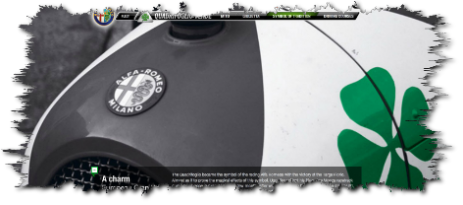
Enzo Ferrari ha sempre ricordato con affetto e riconoscenza il suo fraterno amico Ugo e quei pionieristici e avventurosi anni. Per questo motivo, qui di seguito potete trovare, per gentile concessione dell’autore, un estratto del libro di Leo Turrini “Ferrari – un eroe italiano” dove, meglio che in altre opere, viene descritto quel periodo della loro vita passata insieme.
Giorgio Sivocci (2012)
Enzo Ferrari has always remembered his close friend Ugo with affection and gratitude and those pioneering and adventurous years.
For this reason, below can be found, courtesy of the author, an excerpt from the book by Leo Turrini "Ferrari - an Italian hero" where better than in other works, is described that period of their past lives together.
Giorgio Sivocci (2012)
[Translated by Sylwia Kowalczyk]
